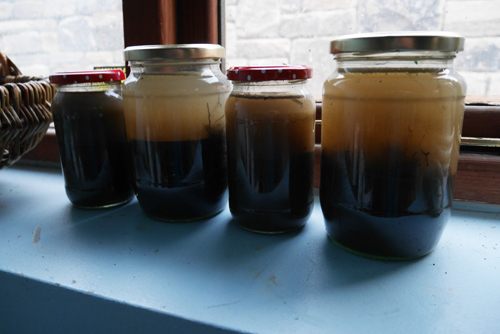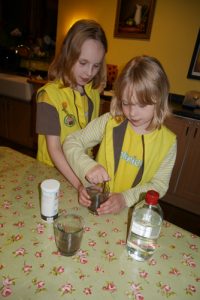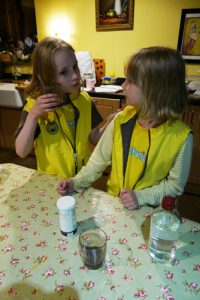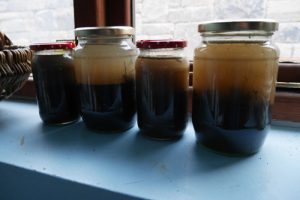
What’s under our feet?
Before embarking on this project I had some knowledge of our soil as well as some major presumptions.
I presumed our soil was acidic and heavy clay, and that is was really thin and full of rocks.
Our fields have been used for pasture and have fed our neighbours cattle for the past few years. They get particularly waterlogged at the bottom of the slopes, but hold a lot of water all over (especially on any relatively flat areas) As well as numerous grasses, there is quite a bit of clover in the fields as well as thistles and a few docks. We also have ragwort which I’m striving to eliminate from our land (it gets less every year, but removing by hand is very time consuming)
Acidity – the plants that grow around our farm (and thrive) are acid loving plants, heathers, bilberries and foxgloves. Also the rock is iron and manganese rich (our water rusts if not treated), and has a tendency to eat through copper pipe!
Clay – ground holds a lot of water, and if you walk about in the mud, it sticks to your boots making them really heavy with several inches of platform sole. Also, if you dig really far down you hit very sticky orange clay.
I didn’t want to plan purely based on my assumptions, so with the aid of two budding soil scientists, we set up a soil lab.
- Intrepid explorers went out to the fields and took some soil samples. Two from each field. The soil was much deeper than I thought it would be which was a really nice surprise. I didn’t reach sum soil with one spade depth, so was really happy. It was really dark with lots of worms. Fabulous stuff!
- We tested the soil for acidity with the high tech equipment of vinegar and bicarbonate of soda.

Mixing the bicarb into the soil We listened to the soil – it fizzed with bicarb – therefore is acidic.

This sample is fizzing - Then we took our samples and shook them up in a jar, and left them for a week or so. The plan was to measure the depth of the different strata of soil as they settled out. The heaviest particles would fall to the bottom, leaving the lighter clay at the top.

Settling soil samples - Result – I found this quite tricky, as the strata weren’t as well defined as I expected. Some soil settled really quickly, and we are on sandstone – was this the sandy soil? It didn’t look like sand. Can I see silt? I can see clay, but not as much as I thought there would be.
The results were split between:
70% silt, 30% clay – silty clay loam and 85% silt, 15% clay – silty loam. The soil is more silty lower down the slopes. - We made soil balls to test the texture. Our balls didn’t feel sandy, and felt really firm between our fingers. It had a matt surface when rubbed, so we deduced we had a clay loam soil.
According to my reading, holds water, nutrients and plant roots well. However it can easily be washed away or become compacted. So, based on this, and the fact I can see my ground gets waterlogged, I need to think about how to handle it and improve it.
My first thoughts are:
- Put a pond in at the bottom of the slopes where the ground becomes more boggy (It’s already holding water, so a pond should be a no brainer)
- Plant some trees – to absorb water and hold soil to stop it washing down hill.
- Plant green manures and cut spring/autumn to add nutrients and organic matter into the soil
- Avoid compaction
– limit areas that tractors can go
– Restrict cattle access by rotation, allowing soil time to recover. Heavy livestock such as cattle compact soil structure and destroy vegetation on parts of a field that they tread most often. This is visually apparent around drinking water troughs, entrances to fields and other parts of the land where the animals congregate. Destruction of soil structure in this way is known as ‘poaching’ and can be seen to be harmful because restoration of vegetation does not always occur spontaneously once the grazing animal is withdrawn. Compacted soil becomes strong making it difficult for new shoots to penetrate the soil and emerge
Any other ideas will be welcomed!